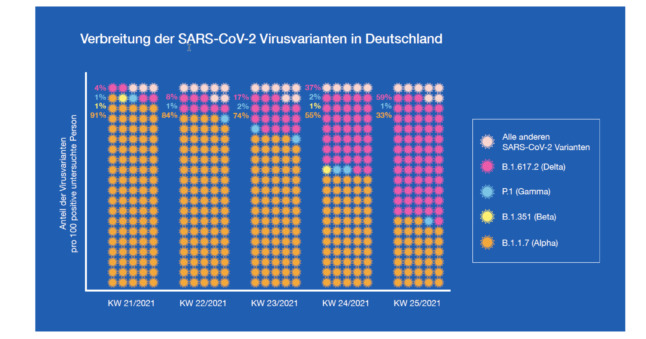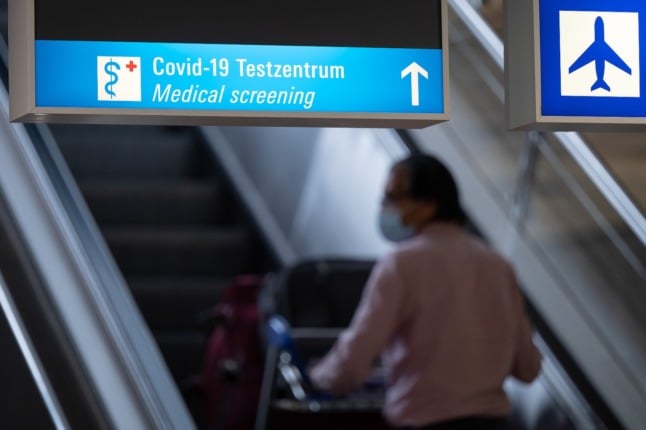The strain of Covid, first discovered in India, is estimated to account for “almost two thirds” of new infections in Germany, the Robert Koch Institute (RKI) said in its latest report on Covid variants of concern.
The proportion of the Delta variant (B.1.617.2) in a sample of new cases from June 21st to 27th was found to be 59 percent, scientists said in the report published on Wednesday evening.
That is significantly higher than the week before, when it was around 37 percent. But the real figure is believed to be closer to around 66 percent – or even greater.
READ ALSO: Germany urged to ‘get more creative’ with vaccine offers as Delta variant spreads
According to a study by the University Medical Centre Mainz, more than 40 percent of all Covid-infected people are unaware that they have the infection.
The share of cases involving the Alpha variant – the previously dominant strain that first appeared in the UK – has dropped rapidly from 91 per cent at the end of May to about 33 percent at the end of June.
“With the predominant proportion of B.1.617.2 (Delta) detections in the genome sequencing sample, it can be assumed that almost two thirds of the PCR-confirmed SARS CoV-2 cases have the VOC (variant of concern) B.1.617.2 and 1/3 are with B.1.1.7,” said the RKI in its report.
Other virus variants of concern currently play a minor role in Germany, as the graphic below shows. The dark pink represents Delta, the orange share is B 1.1.7 (Alpha), the blue colour is P.1 (Gamma), first discovered in Brazil, while yellow is B.1.351 Beta, first detected in South Africa. Other variants are in light pink.

What does the rise of Delta mean in Germany?
The sharp increase of the Delta variant over the past weeks has been accompanied by a slight increase in the number of Covid cases, even though there is still a low 7-day incidence rate, the RKI report said.
On Thursday, Germany logged 970 cases within 24 hours, and 31 deaths.
The 7-day average of cases in Germany is now 6 percent above the previous week, while the decline of active cases compared to previous week is slowing down.
The infection rate rose slightly to 5.2 cases per 100,000 people within seven days, up from 5.1 the previous day.
Apart from Frankfurt am Main, which has an incidence of 20.0 cases per 100,000 people, all 412 urban and rural districts have an incidence rate under 20.
The RKI said the high number of variants of concern justifies Germany’s focus on analysing positive Covid cases to detect the spread, and said the country needed “to adapt public health measures accordingly”.
Where are cases being detected?
Around 10 percent of Delta cases indicate “possible exposure abroad”, said the RKI. The most frequently mentioned countries were Russia (72 cases), Spain (47) and Afghanistan (29).
However, most outbreaks have been detected in Germany in private households, workplaces and schools – both for the Alpha and Delta variant.
The absolute number of cases in outbreaks is still lower for Delta than for Alpha, says the RKI.
Over four weeks from June 7th to the beginning of July, Delta accounted for about 1,100 Covid infections in Germany. Of these infections, about 350 people were hospitalised, according to research.
Germany this week lifted the travel ban on countries with widespread Covid infections linked to the Delta variant due to it being the dominant variant in the Bundesrepublik.
What’s the reaction in Germany?
Due to this development, the president of the German Society for Immunology, Christine Falk, called for restrictions like mandatory masks and testing to remain in place.
“If we do nothing, this thing will go through the roof,” she told DPA. “You can already draw the conclusion that this variant will contribute to more people getting infected again. Because it’s easy for the virus to jump from one person to the next.”

A woman gets tested at an outdoor testing centre in Berlin’s Marzahn district. Experts believe continued testing could be key to fighting Delta. Photo: picture alliance/dpa | Wolfgang Kumm
Politicians and experts are also calling for more to be done to get people vaccinated.
The latest data shows 57.1 percent of the German population has received at least one dose, and 39.9 percent are fully jabbed.
But over the past two weeks, the number of vaccinations per day in Germany has decreased significantly.
In order to fight the Delta variant, the RKI says Germany needs to target an even higher proportion of the population. They say 85 percent of people aged 12-59, and 90 percent of people aged 60 and over need to be fully vaccinated.
READ ALSO: Unvaccinated children could jeopardise herd immunity, German health experts warn
“If this vaccination quota is reached in time, a pronounced fourth wave in the coming autumn and winter seems unlikely,” the public health institute said in a paper released on Monday.
“The results [of our study] show that under the assumptions made, in particular an increasing dominance of the Delta variant, the vaccination campaign should be continued with high intensity.”
What’s happening in other countries?
In the UK, where the Delta variant has been dominant for weeks, the 7-day incidence has risen to just over 256 cases per 100,000 people.
Meanwhile, the highest number of daily cases since January was recorded in Britain on July 7th, with more than 32,500 infections.
The number of new infections as well as deaths and hospital admissions each rose by more than 40 percent last week compared to the previous week, British authorities say.
They say the rising numbers are caused by the Delta variant, which is responsible for almost all coronavirus cases in the UK.
Despite this, British Prime Minister Boris Johnson is planning to lift all Covid regulations on July 19th. The government expects that the number of new infections could rise up to 100,000 a day, but says the country has to learn to live with Covid.
In the USA, too, the particularly transmissible Delta variant is already dominant, according to research by the CDC. The mutant’s share of new infections rose to 51.7 percent in the two weeks up to July 3rd, the agency reports.
The share of the Alpha variant, which has been dominant up until now in the US, has dropped to 28.7 percent.
An earlier version of this story said the Delta cases mentioned had been logged in the last week. We amended the story to say the cases were reported from June 7th until the beginning of July.




 Please whitelist us to continue reading.
Please whitelist us to continue reading.
Member comments